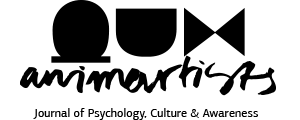Interviewer: Maria Polikreti
Psychologist
Translation: Fragiskos Leontis
“Several years ago, when I met with Yiorgos Kavounis’ works, I saw an aspect of art that one cannot easily come about in the marathon of the postmodern aesthetics. I can’t deny that my mind was filled with images of some secret establishment with Luis Buñuel and Charles Bukowski conversing about morality and art. Wittgenstein once told us that “ultimately, aesthetics and morality coincide”. The artist is removed from the “musts” and “don’ts” and imprints an imaginary world, where morality is discharged and the repressed guilt is detonated…”.
 Yiorgos-Panayiotis Kavounis was born in Athens, Greece, in 1979. He attended the Athens School of Fine Arts, from which he graduated with honours in 2007. In 2005 he attended the Fine Arts department of the University of Valencia (Spain) for six months. He has performed a personal exhibition (K-Art Gallery, Athens 2011) and has taken part in important collective exhibitions: Art-Athina/ International Contemporary Art Fair of Athens 2014/2015/2016/2017, Art-Thessaloniki/ International Contemporary Art Fair 2016, ReMap 4/ International Contemporary Art Platform (Athens, 2013), Avra Art Gallery 2016 (New Jersey, USA), “The Human Form in Art” (Technopolis, Athens 2009), etc. His works have received distinctions in art competitions (Kon. Andreou Public Welfare Institution 2011, Belle Art Lamia 2007) and can be found in private collections in Greece and abroad. In the Fall of 2014, he took up tattooing professionally.
Yiorgos-Panayiotis Kavounis was born in Athens, Greece, in 1979. He attended the Athens School of Fine Arts, from which he graduated with honours in 2007. In 2005 he attended the Fine Arts department of the University of Valencia (Spain) for six months. He has performed a personal exhibition (K-Art Gallery, Athens 2011) and has taken part in important collective exhibitions: Art-Athina/ International Contemporary Art Fair of Athens 2014/2015/2016/2017, Art-Thessaloniki/ International Contemporary Art Fair 2016, ReMap 4/ International Contemporary Art Platform (Athens, 2013), Avra Art Gallery 2016 (New Jersey, USA), “The Human Form in Art” (Technopolis, Athens 2009), etc. His works have received distinctions in art competitions (Kon. Andreou Public Welfare Institution 2011, Belle Art Lamia 2007) and can be found in private collections in Greece and abroad. In the Fall of 2014, he took up tattooing professionally.
At what age do you remember yourself painting for the first time?
At a very young age, I was probably 3 – 4 years old. When I was around twelve I stopped painting completely, I do not remember nor do I understand the reason why. The need returned to me when I was seventeen.
To what degree did your studies in The School of Fine Arts influenced your style and the aesthetics of your artistic process?
My case is somewhat peculiar since I was kind of unlucky. My professor was also the Dean, which meant that he would come to the workshop only once a week, instead of three times a week like all the other professors. As a result, all Friday workshops were packed with people. I gained many things through the years, but I would have liked to have gained even more. All the work was done with my fellow students: exchange of knowledge, everyday occupation with the subject and mostly, personal research and a lot of work.
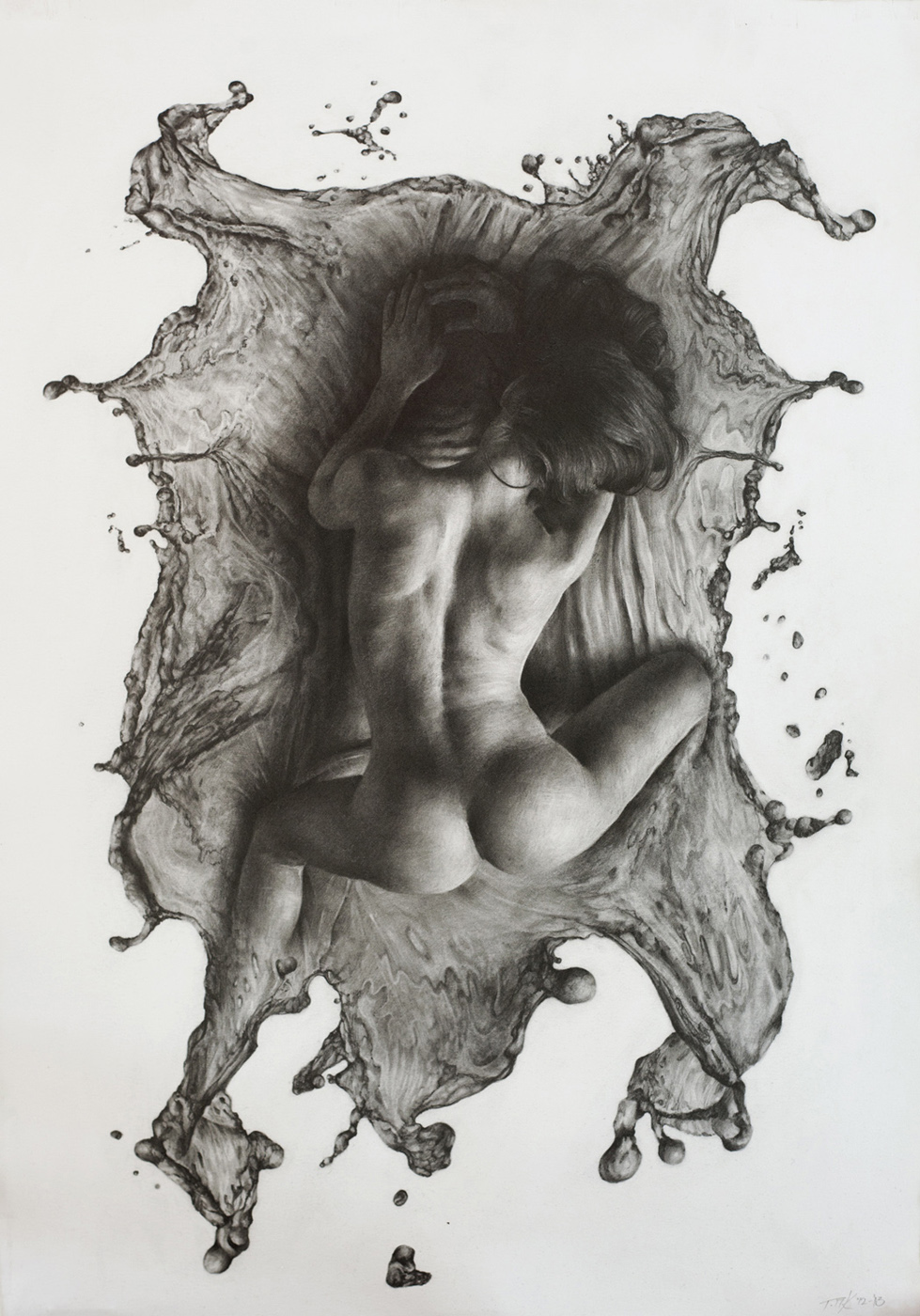
“Bilbao”, 53 x 37cm (pencils on paper) 2012-13
I am wondering whether the range of your aesthetics was formed upon the completion of your studies, or whether it was an approach that motivated you from the beginning.
As far as my aesthetics is concerned, it is something that was pre-existent. It is part of my personality, something that has been “tormenting” me all along and I always had the need to work this way. Halfway through my first year of school – with my professor’s approval – I abandoned model study and started looking for ways with which I would produce what concerned me. Even with other means/tools (e.g. video) with which I experimented during my course, my approach was always the same. In time, all this evolved into its present form. In short, even before I was admitted to the school, I knew that I would never paint still life and such themes. The Cynics refer to it very successfully: Nature has created everything perfect. Also, I find painting motifs unbearable, since this way, the spontaneity and the becoming are lost. My interests are the human psyche and the passions. It is painful, but also beautiful procedure, which helps me know myself better.
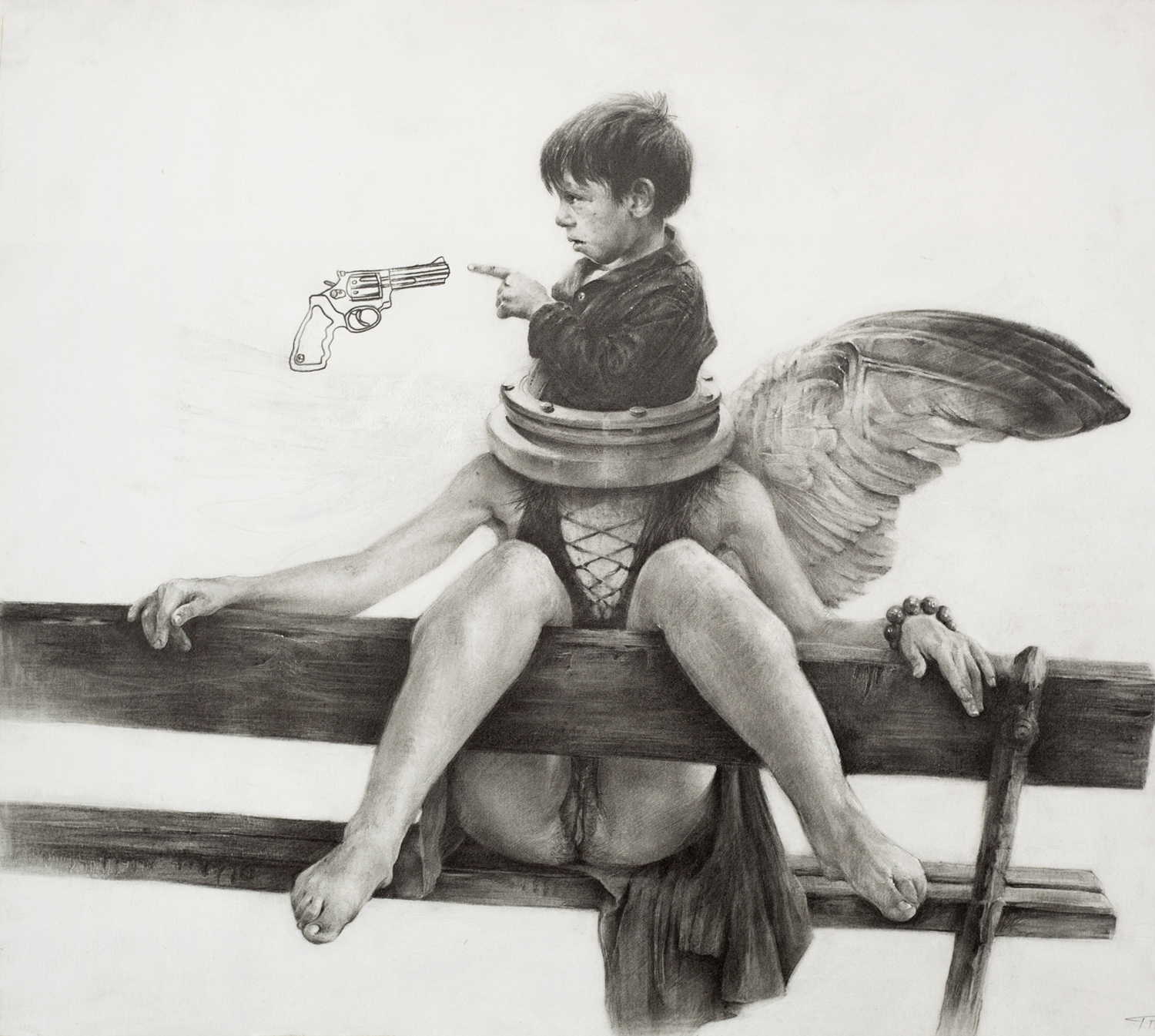
Untitled, 36 x 42cm (pencils on paper) 2012
Was there a first conception that signalled the emergence of the individual style that you maintain in your works?
As I mentioned before, it just happened. I needed a way out and I found it in painting. The character was always there in the form of an “itch”, a tendency, since I first started to question and to understand the world around me (mid – adolescence). Every person carries his cross and mine is these images.
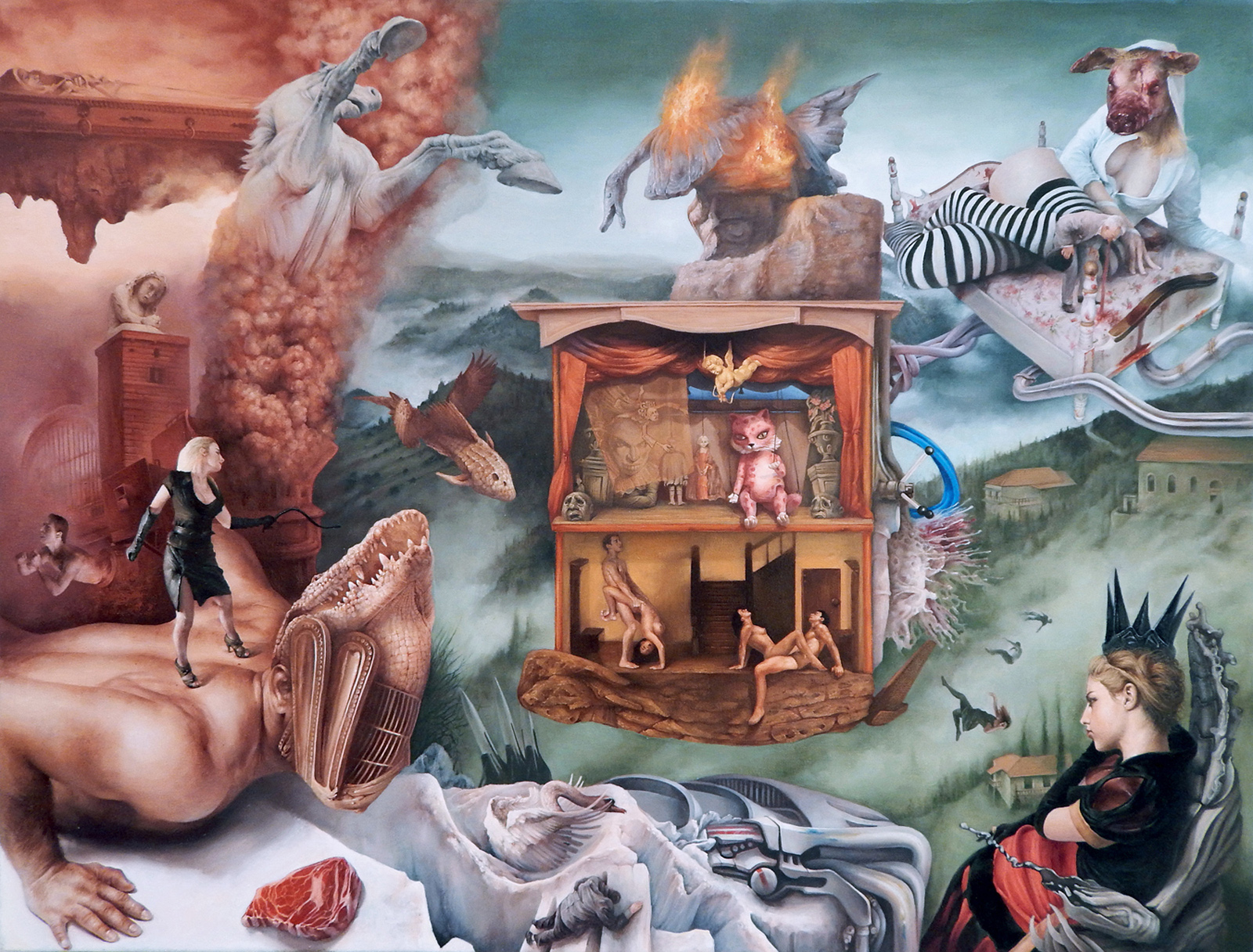
Babylon; look her in the eyes”, 75 x 57cm (oil on canvas) 2013-15
We would like you to tell us a few words regarding your course after the School of Fine Arts and your first participation in exhibitions.
Every spring, a graduates’ exhibition takes place, which is visited, among others, by gallery owners. As a result, cooperations are formed. At least this is how I began, with my first collective exhibition at Gerasimos Kappatos’ Gallery and afterwards at Maria Christofi’s K-Art Gallery (not in business anymore), where also my personal exhibition took place in 2011.
How much time do you spend preparing and executing one of your works?
I spend a lot of time on drafts and I approximately need 12-15 days of work for a small drawing to be completed, but it can also take much longer since I re-examine and modify or even radically change many parts of the executive part. In general, it takes from 15 days to 1.5 – 2 months for the bigger ones. Some have taken even more since I wasn’t satisfied by the end result. The more I strain over a work, the more I gain for the next one.
What would you say is the driving force that pushes you to ascribe this exceptional detail to your works?
My obsession with the details is a purely idiosyncratic element, a part of my character. Back when I was a student, I was experimenting and partly trying to expel it (I have a spirit that begs to differ and I constantly fight even with myself). In time I accepted it, however, I realised that from a point onwards it does not please me and it does not benefit me to push my art further towards photorealism, so I started looking for a different mannerism to channel my needs. Already, in my last 2 or 3 works, new elements have been included that in time will be multiplied.
An artistic composition manages one or more meanings? And on what does its interpretation depend on?
An ambiguous composition has as many interpretations as the eyes that see it. From then on, it depends on what receptors one has so that he/she can deconstruct an image.
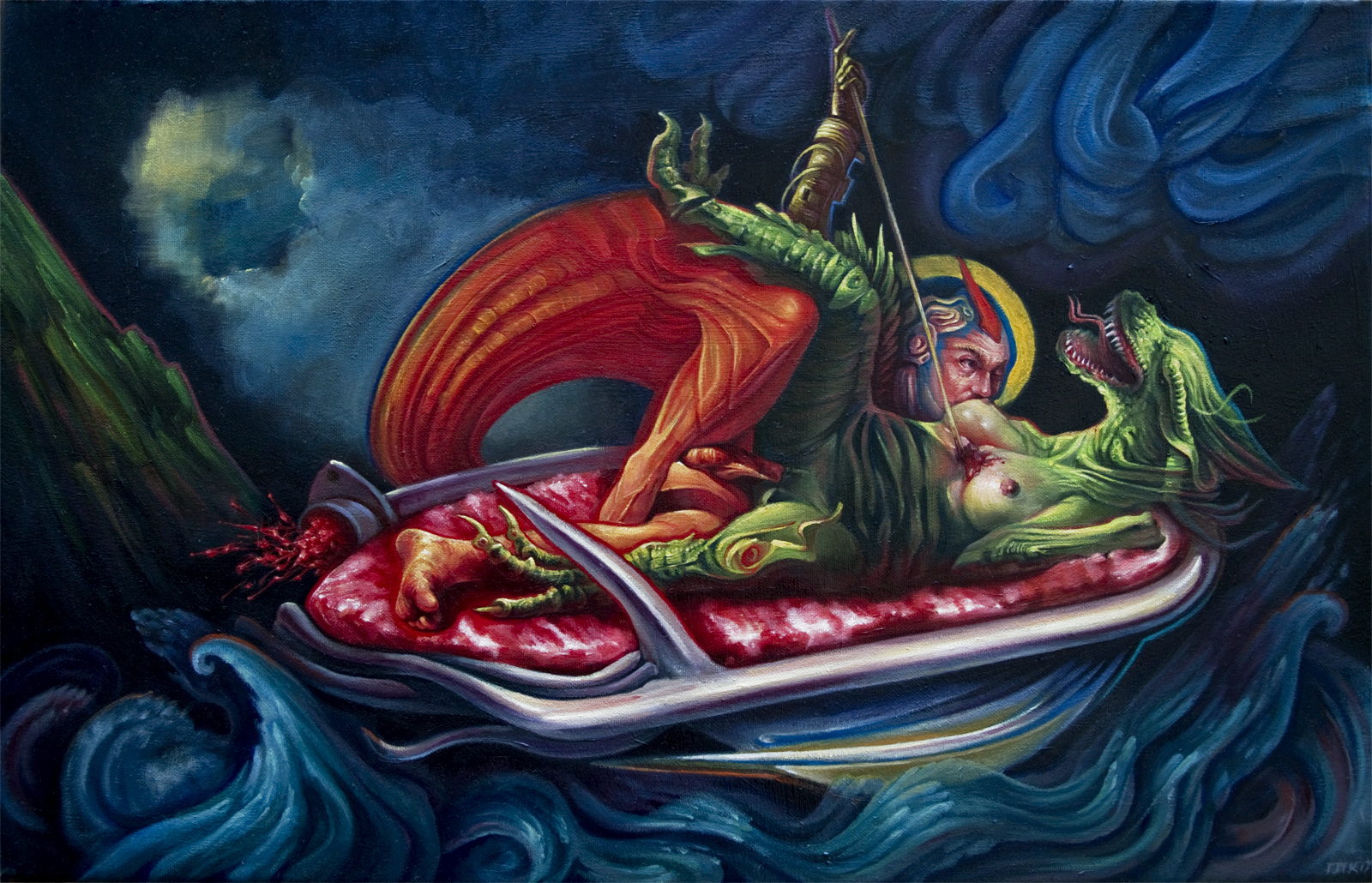
«And the dragon, as a lamb, dies a God, 54x34cm (acrylics and oils on canvas), 2017
Note: The title is a variation on the verse of the poem “Christmas” by Mikelis Avlichos (1844-1917).
A characteristic element in your work is the depiction of flesh, which sometimes illustrates the human body and sometimes that of animals. What concerns may frame this aspect of your creation?
The flesh interests me because it is the human being, its passions, its troubles, its shame. The animals identify with it and present many different aspects of it and that is why they exist in my paintings. Also, some futuristic and past elements are involved. I always engage the bipolar. I am also like that as a person, I cannot be imprisoned in one side, I want the other one as well, I want to grasp the best of both worlds. That is also why I cannot stand people who are “recruited” and who adhere to obsessions and ideologies, whether it is with regard to art or anything else; they are of completely no interest to me. All of my painting is based on the harmony of contradictions. It is the Helm.

“Palm Sunday”, 60 x 80cm (pencils & ink on paper) 2011
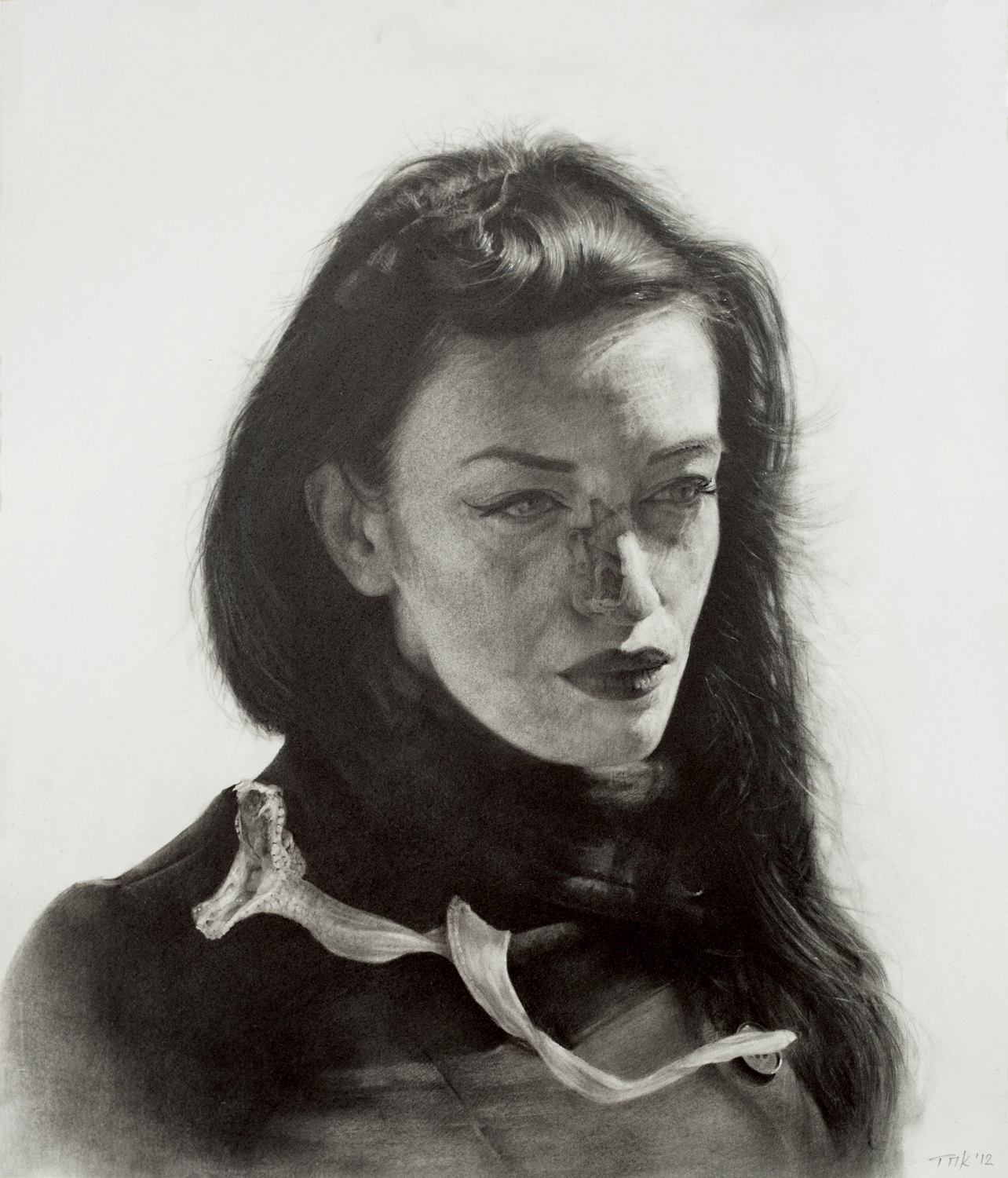
”Seaweed for silk ribbons”, Greek expression that stands for ”chalk for cheese”, 45 x 38cm (pencils on paper) 2012
From then on, there are many things for which I cannot give a clear answer because most of the times there just isn’t one. I aspire to move beyond rationalisation and rationalism. This whole process, apart from a few separate moments, is not exceptionally pleasant. The concerns (regarding composition, technique and meaning) are intense and strenuous. Satisfaction comes when a work is completed and goes away again when a new one begins. If I could give you final answers on why I combine whatever it is I combine and how I do it, I would not need to paint again, I would be done for. In essence, I hunt and look for myself through all these paradoxical dreamy complexes.
«…I hunt and look for myself through all these paradoxical dreamy complexes…»
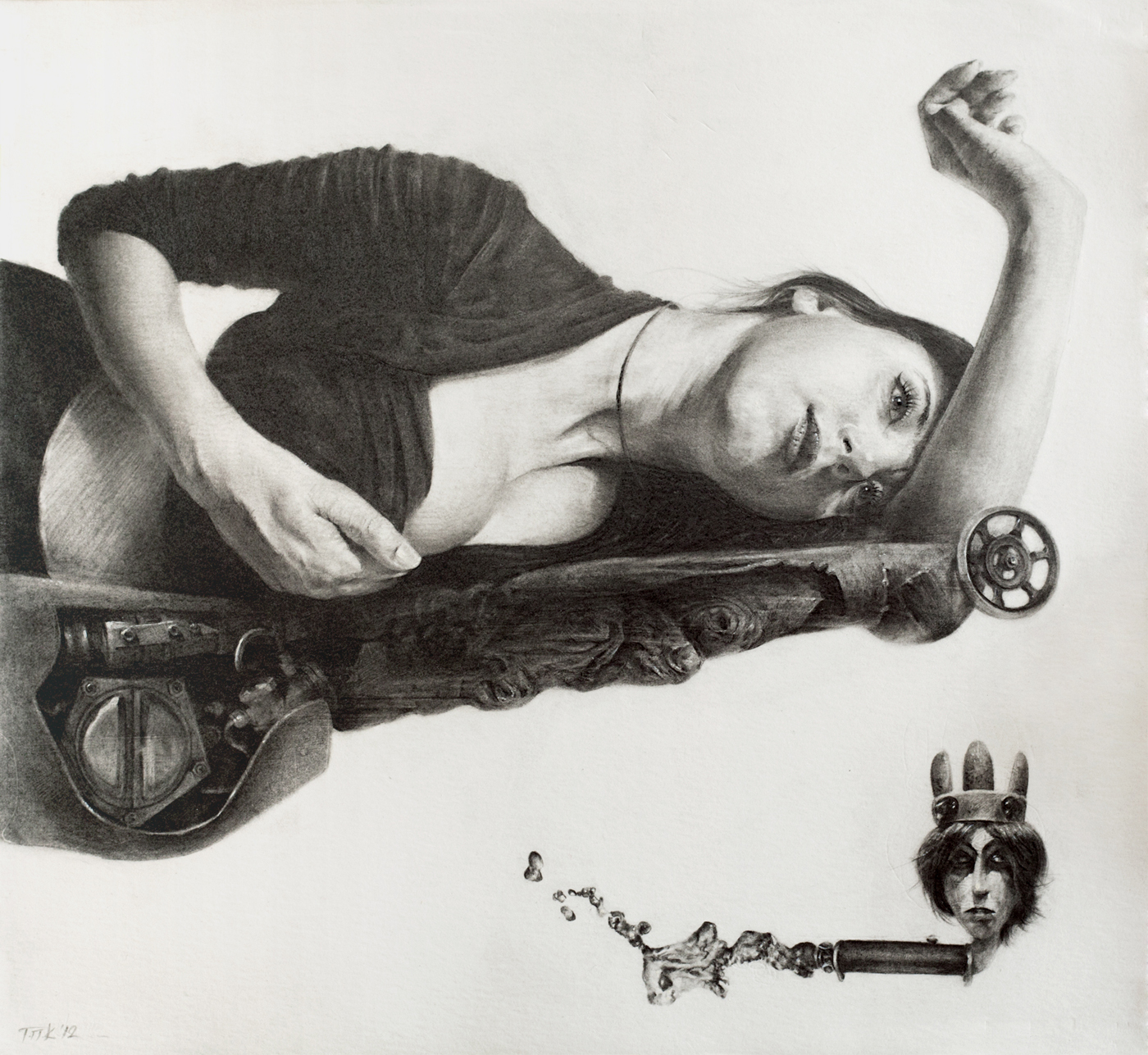
“Sils-Maria”, 33 x 28cm (pencils on paper) 2012
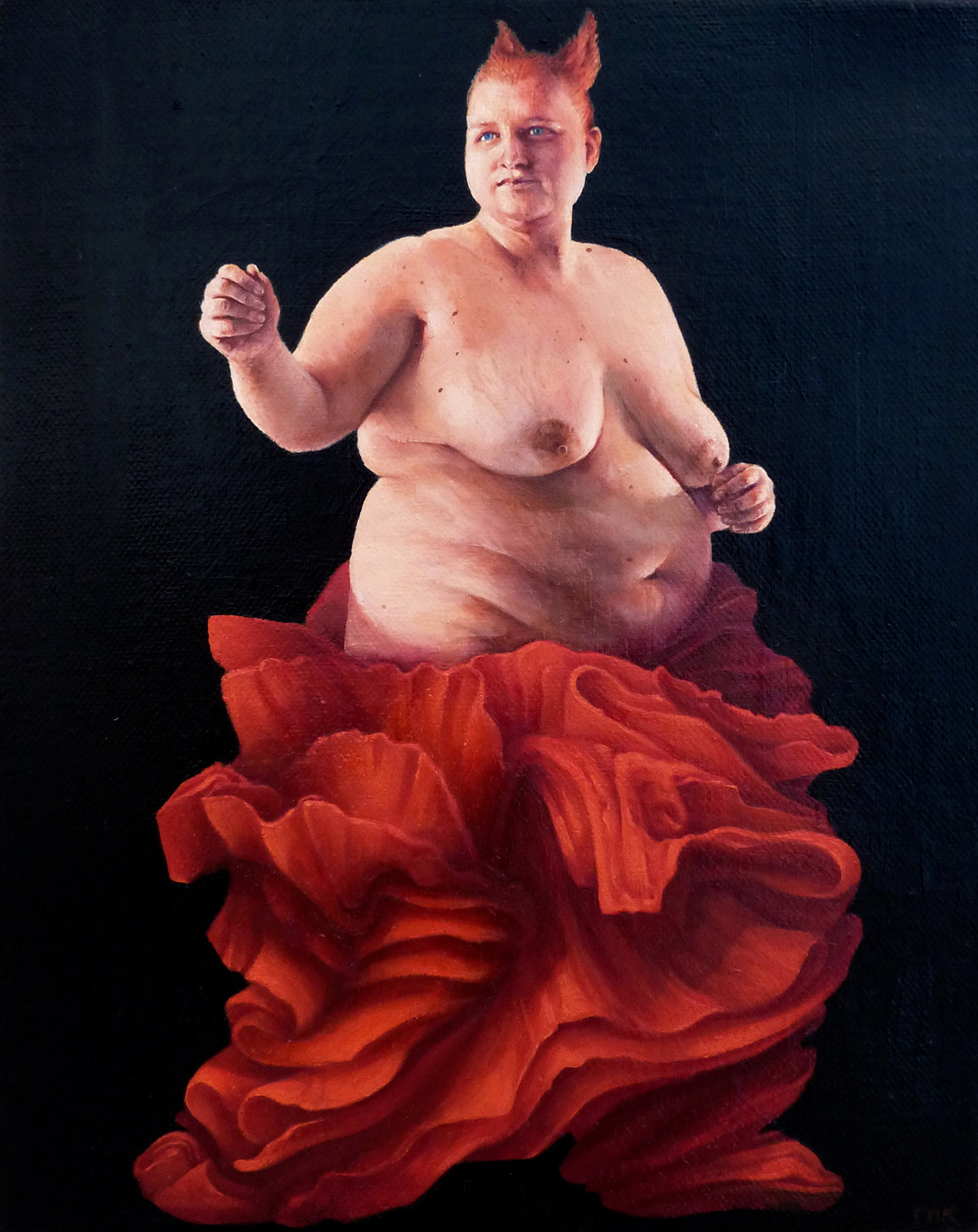
“Nights”, 24 x 30cm (oil on canvas) 2015
Note: Based on the same-named poem of Kostas Montis (1914-2004)
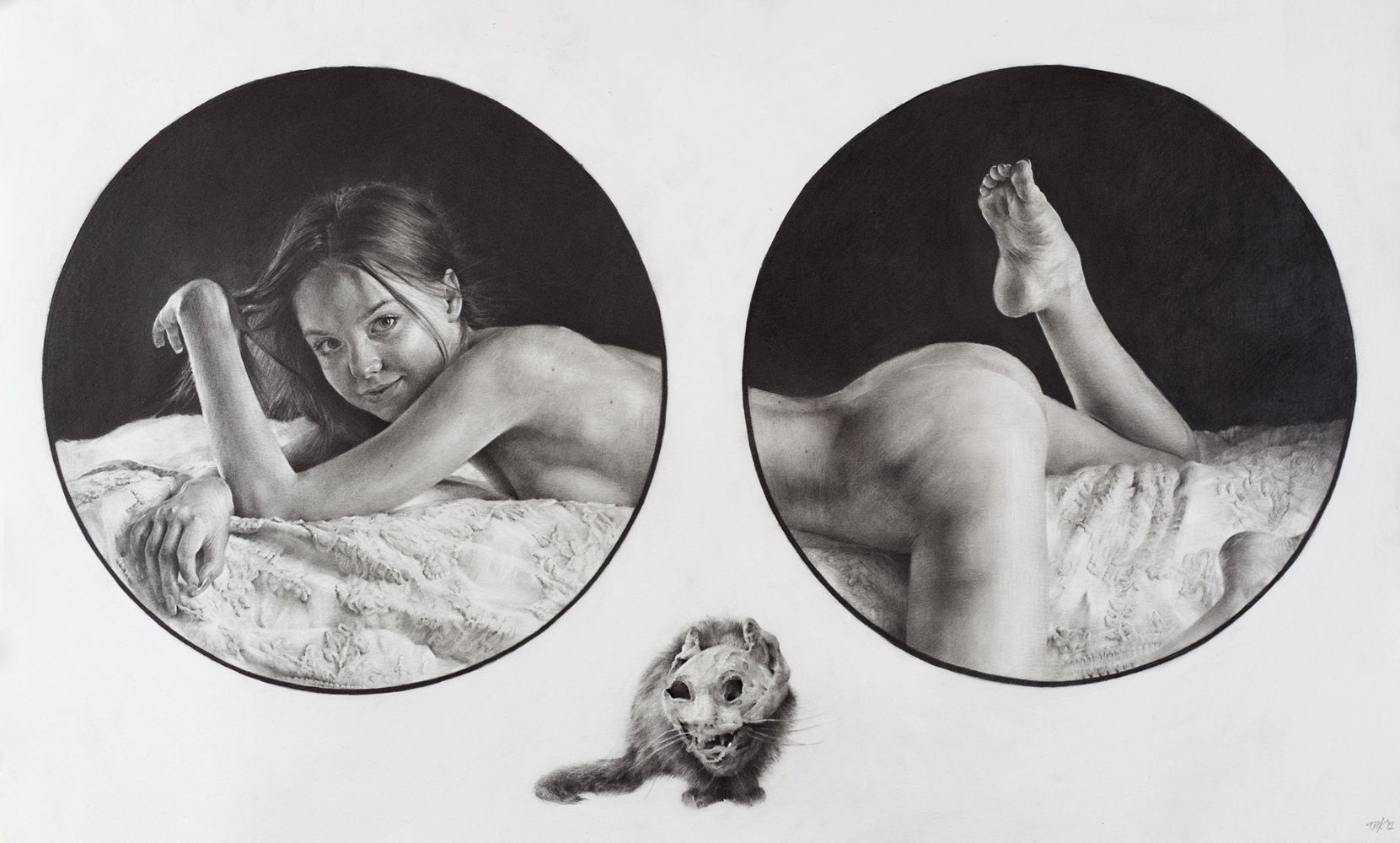
“Envy/Jealousy”, 80 x 48cm (pencils on paper) 2012
By observing your works I discern an intense erotic element through the austerity of the carnal depiction. What is the repercussion of this style in the artistic field?
Because of my style, my work can be interpreted in various ways. The erotic scenes I use are like vessels, they carry symbolisms and situations. They usually don’t react directly with the carnal pleasure itself. A good example is the painting “The Eternal Husband”, which is based on Dostoyevsky’s novel of the same name. The whole erotic scene bares and makes the insinuations I present even harsher. I turned down a private exhibition, in an important art gallery of Athens, because I was asked to limit this element. In a later time, attending exhibitions in the same art gallery, I observed that they exhibited “erotic” works, which were expressionistic or abstract. The problem was the realistic acidity of my own depictions. When shame is served cold, there is a problem, and it is called guilt (something that cannot be easily transcribed into sales for the gallery owner).
“When shame is served cold, there is a problem, and it is called guilt”
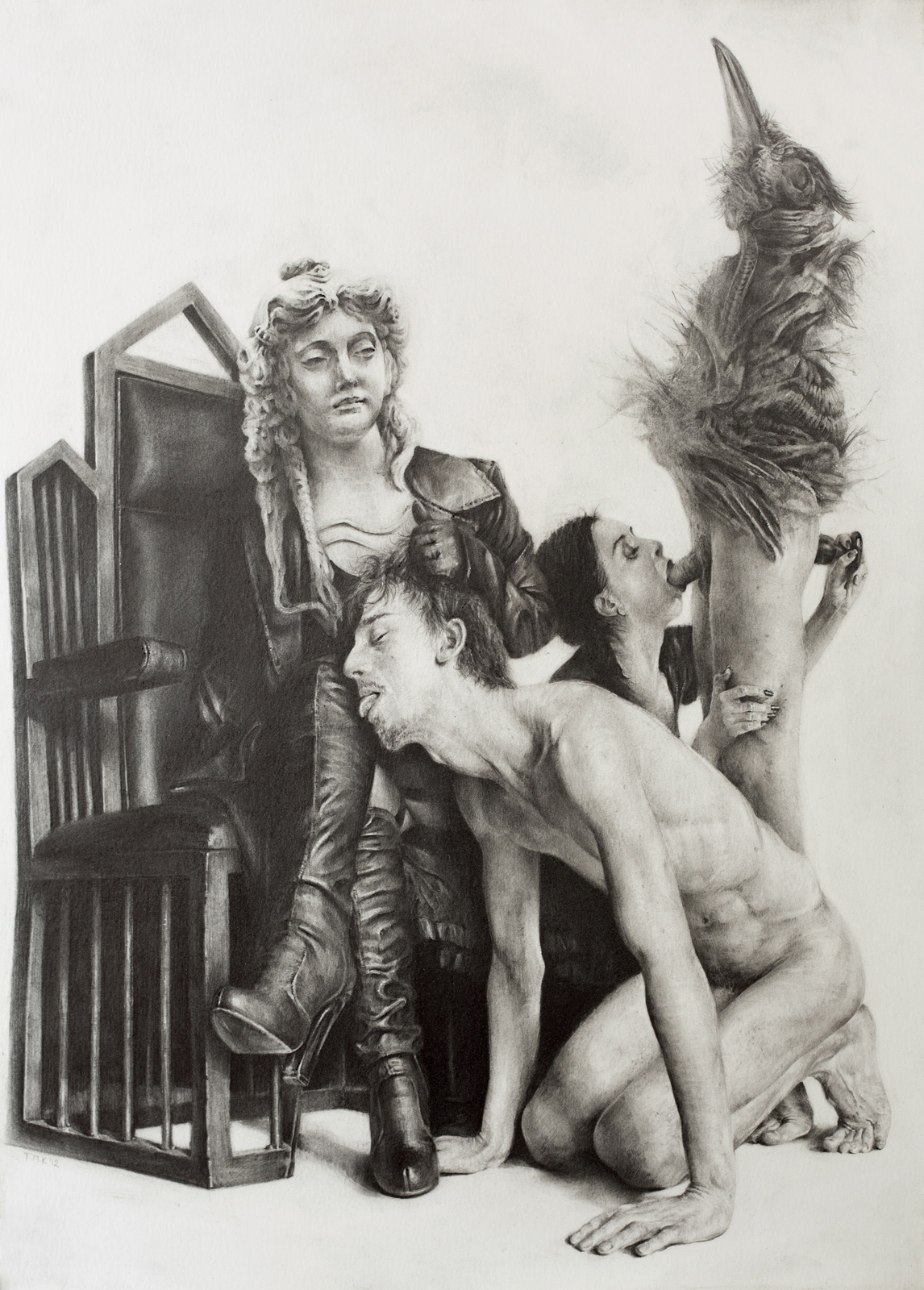
“The eternal husband”, 50 x 35cm (pencils on paper) 2012
All this comes out as an effort, to break a barrier…
I believe that this is the beauty of it. Painting for me is not a desire, but a need. It helps me to wake up in the morning.
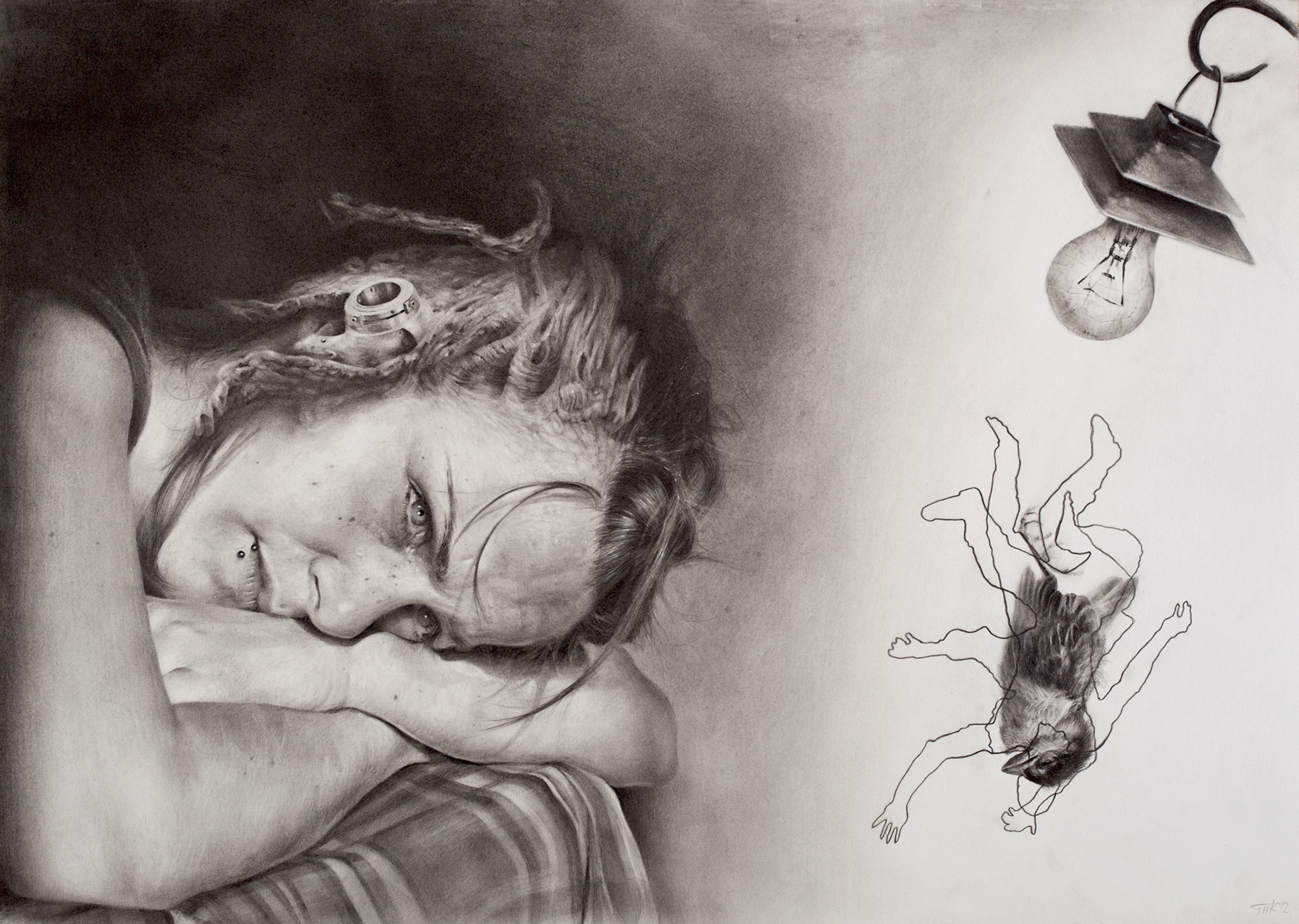
“Infidelity’s wall”, 41 x 58cm (pencils on paper) 2012
So is your approach towards art a tendency toward liberation?
The word liberation is followed by the preposition “from”, so it is always relevant, it depends on the social context of each era.
I would say that it is a Bacchic approach to situations. The irreconcilable, the anarchistic, the Bacchanalian. It is more like a tendency, I just go, and I discover on the way. A constant discourse with myself with an emphasis on the ambiguous and the strange that hide behind the moral conventions. I am concerned and interested in the discharge of the mediation of concepts, the authority of words and their passive acceptance. If you discontinue a word from the Grammar, this word automatically ceases to exist. The Language is the greatest dictator because it conserves meanings. Nature does not know of definitions, shame, sins, of the transcendental, of absolute truths, of beauty and ugliness, of good and evil, of Heaven and Hell… These are human interpretations, which are relevant. Only facts are objective. Behind these, lie studies that influenced me through the years and fed, sharpened my thought and my curiosity: Nietzsche, Unamuno, Dostoyevsky, Heraclitus et al. I must also mention the great Polish director Andrzej Zulawski whose aesthetics have influenced me heavily. When I saw “Possession” (1981), I stood in awe.
«I am concerned and interested in the discharge of the mediation of concepts, the authority of words and their passive acceptance»
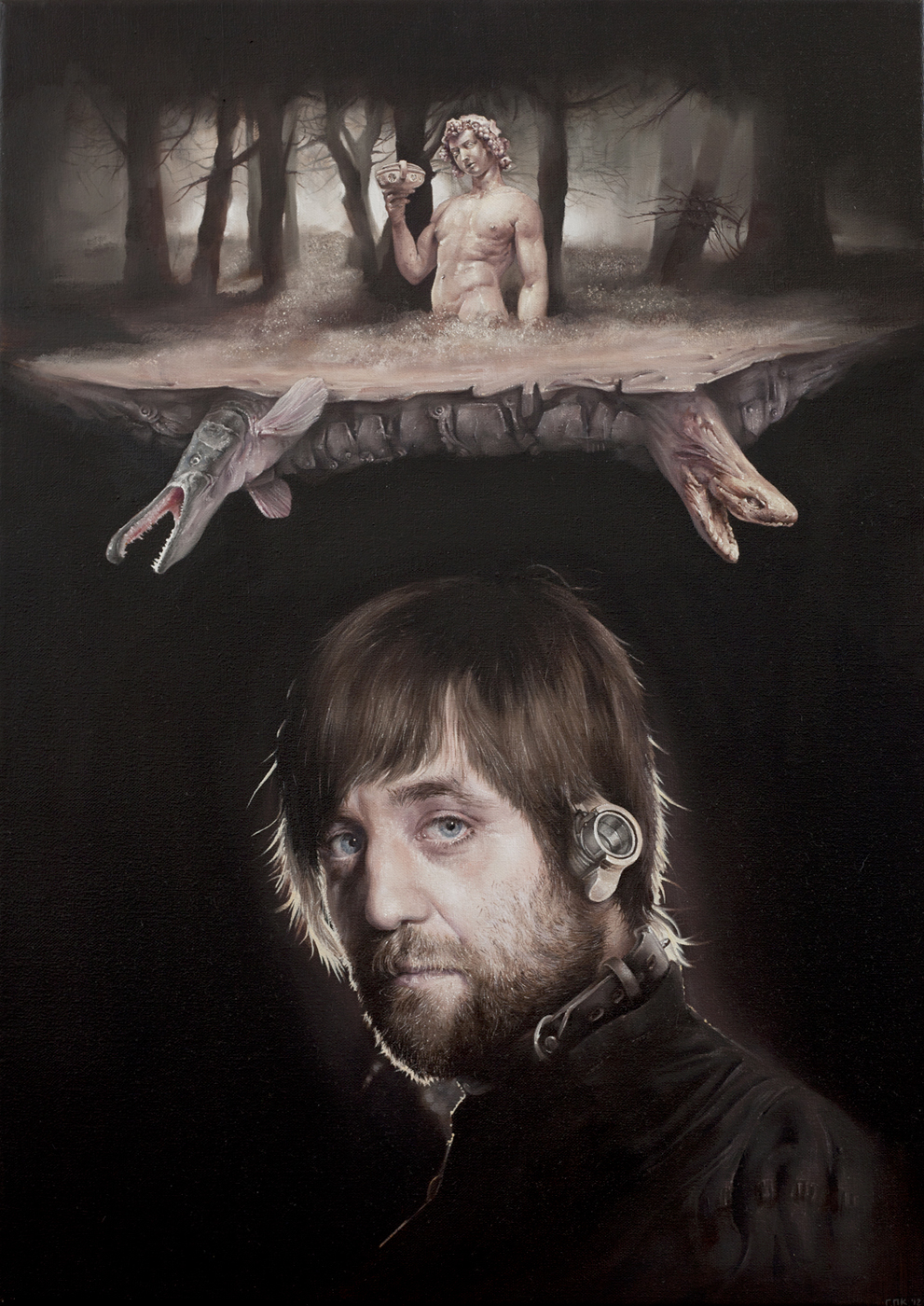
“Bacchus”, 50 x 70cm (oil on canvas) 2012
I wonder how you perceive a society without morality…
It is something that does not concern me. Scattered friendly discussions come to mind: “how would society be without or with, this or that political direction? What must be done?”… A person must be in a constant flow, or else he loses his individuality and his uniqueness. Plato banishes poets from his ideal “Politeia” (Republic). Anything that questions and demolishes – isn’t that what serious poetry does? – cannot go together with it. The Republic needs all kinds of “-isms” and survives thanks to them. If I give you a definition of how a society without morality would be, I would have given you another “-ism”, another moral standpoint. This is the job of politicians, and I am not a politician.
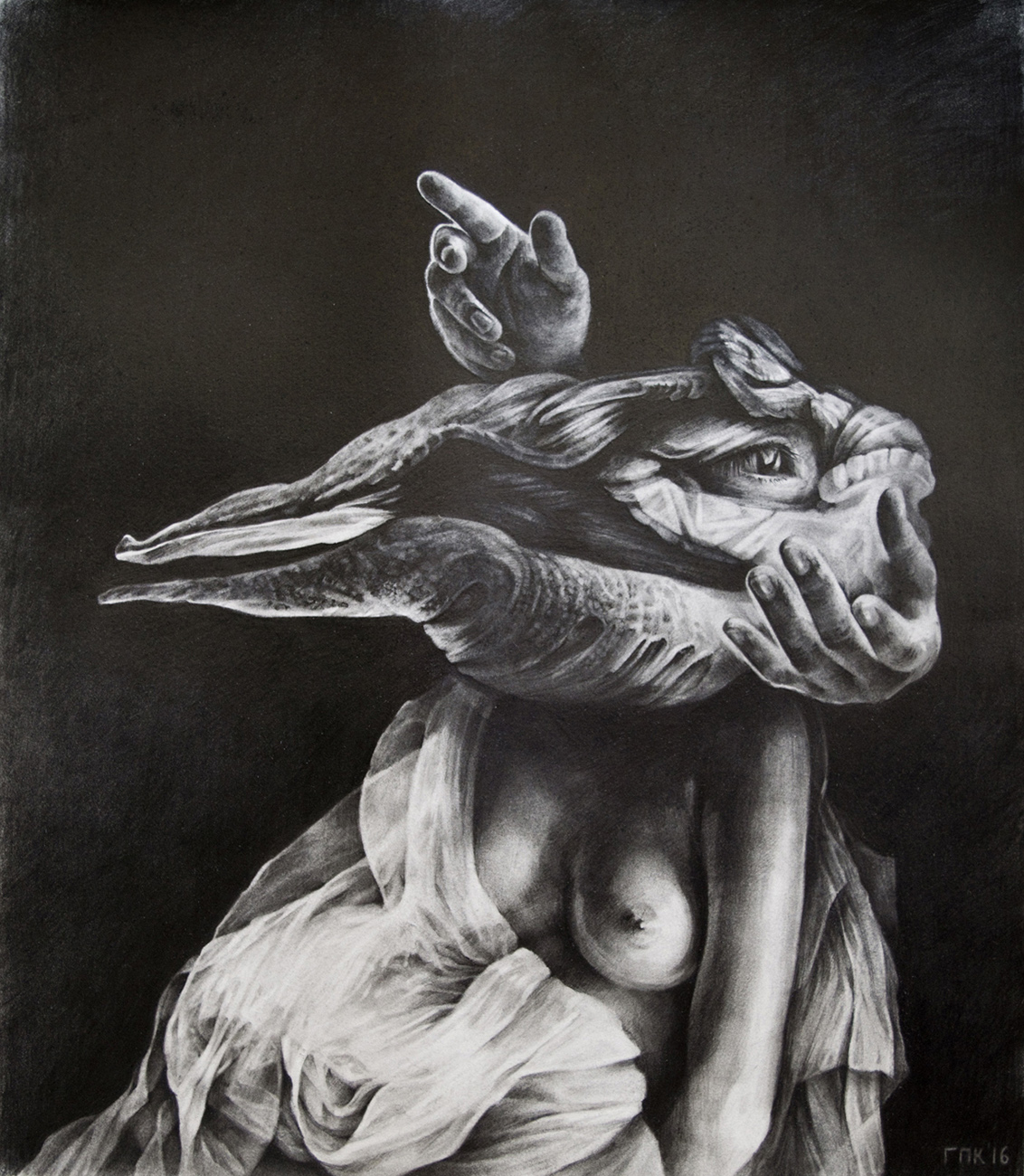
“Genealogy of Morality”, 43 x 38cm (pencils on paper) 2016
Do you reserve a cohesion between your works?
Yes, I do not work with (different) concepts as others choose to do. Since my first painting, I cannot remember how many years ago, up until the last, all of them complete each other, in a sense of meaning. Step by step. (The only exceptions being a few paintings , during my student years, due to immaturity).
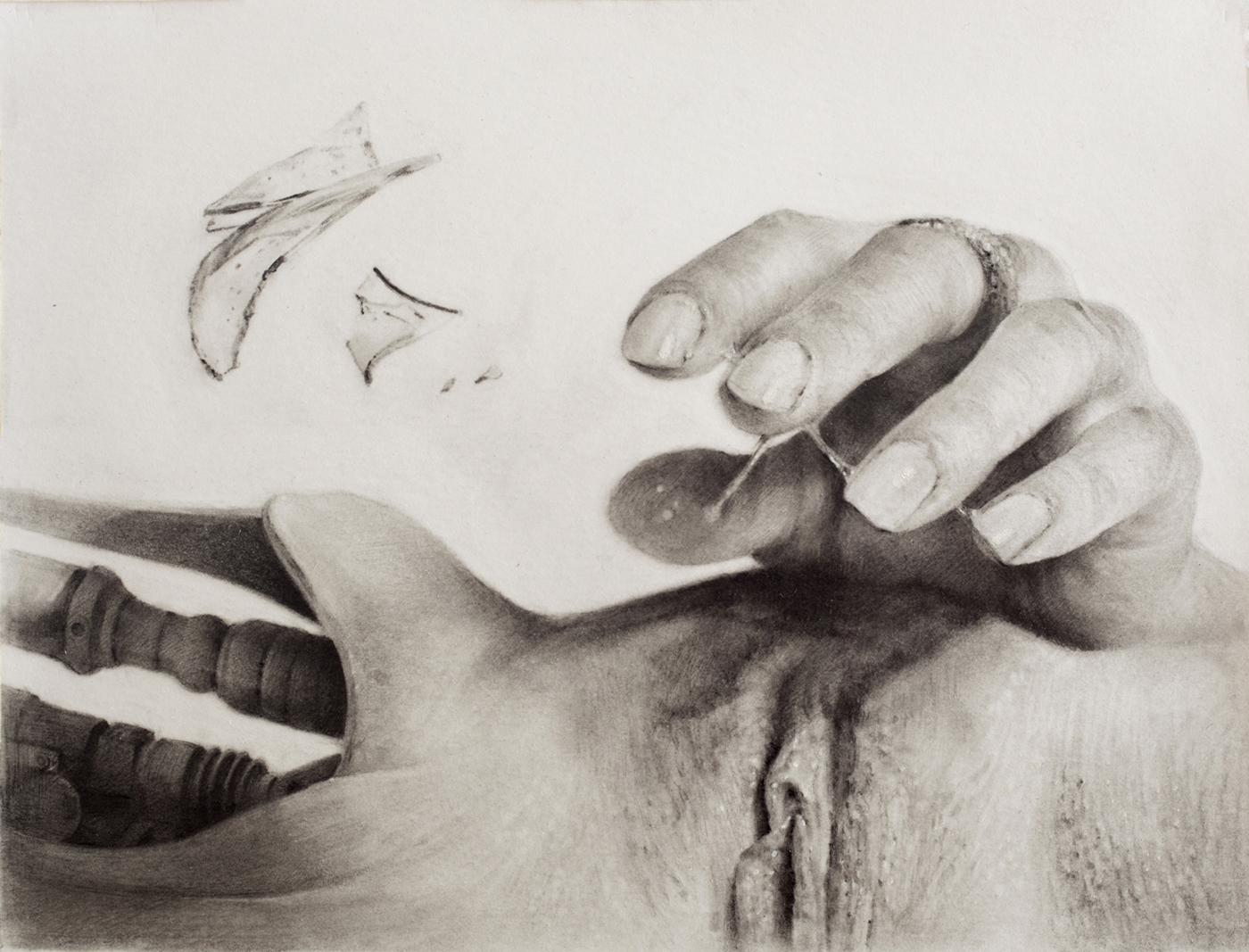
Untitled, 18 x 24cm (pencils on paper) 2012
What are the role of historians and art critics and the interaction with the artists?
Their role is scientific research, study and interpretation of the various art forms, the documentation of historic trends/movements, the curation of exhibitions, the catalogue documentation for galleries, museums, foundations, etc. In a few words, exactly what their name suggests.
As far as the second part of criticism, (with which not everybody identifies with – some claim to be just historians), I believe that there are very few who, indeed, criticise harshly. Sharp criticism, that is. For example, in literature, in cinema, in music, there is such criticism. Regarding art, I rarely read anything that I consider negative, and as a result, there is artistic arbitrariness. So as not to be misinterpreted, I have to clarify that not all criticism can be to the point, nor can all art critics define the artistic reality (e.g. the Rejects’ Lounge, 1863), however, I think that they can and should “stimulate” it. The “conflicts” must be on purpose because they generate consideration, uncertainty and anxiety. These elements contribute to the materialisation of quality works. Painting is not something easily digested or something funny, to be used as a pastime.
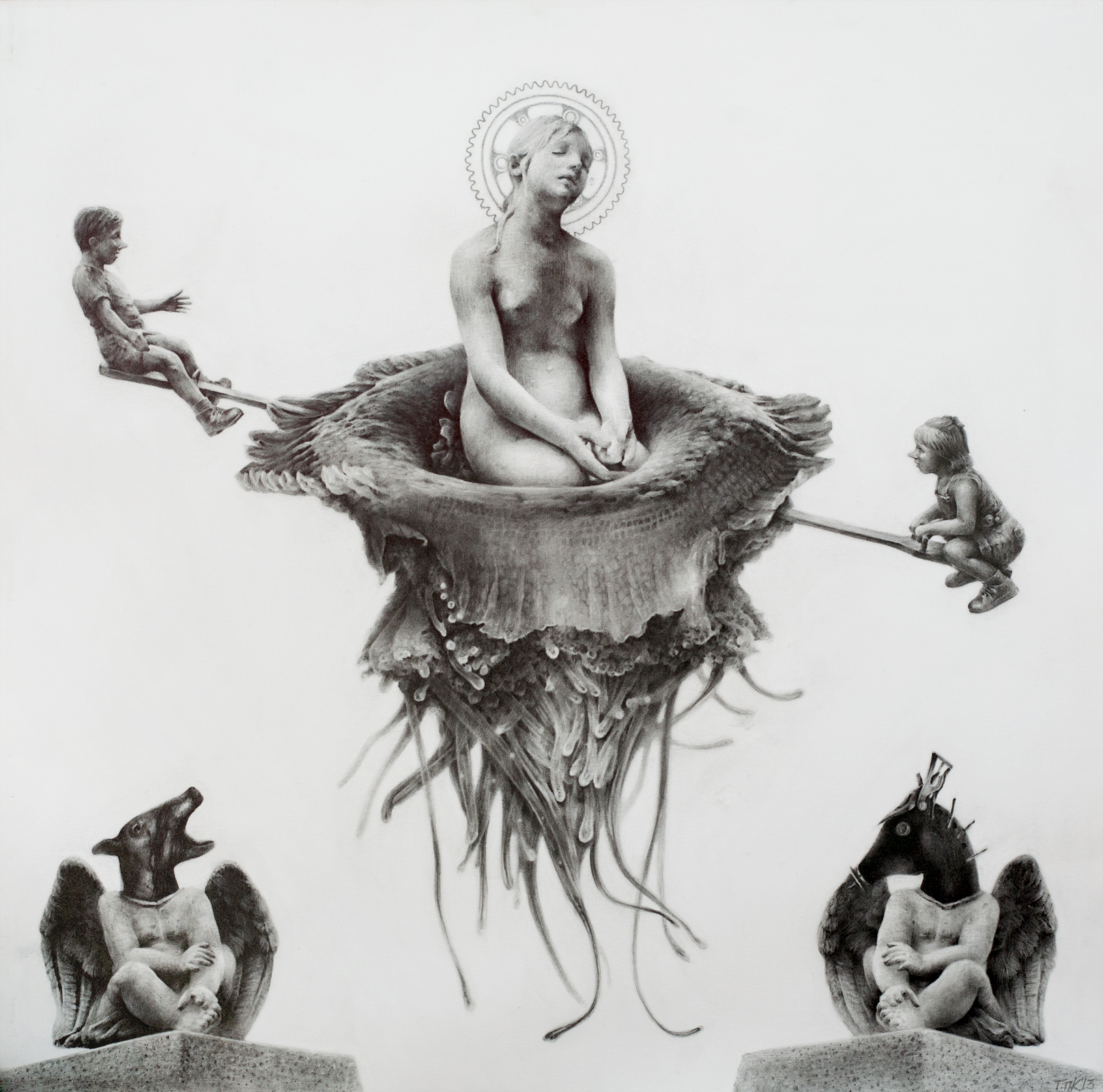
Untitled, 44 x 44.5 cm (pencils on paper), 2013
In recent years you have been active in the creative space of tattoo art. How did you come to this choice and what are its prerequisites compared to painting?
I always had it in mind (I started getting tattooed around 1997 – ’98), however, for various reasons, it came up about two and a half years ago through an internet add, something that saved me from the position of substitute Art teacher ( I was filing for the position at that point), which I escaped. I taught a class 7 -8 times during my practice, and I did not find the experience very pleasant. I guess not all things agree with every person.
Tattooing, as I see it, referring to the present, is an applied/decorative form of art and surely the most difficult – due to its specificities – to claim as your own. It demands respect for the flesh, a lot of patience and the apprenticeship next to someone is a one-way street. On the other hand, from a holistic point of view, it cannot be identified with the essence of the term Art. The basic reason being the body is the “boss” – with its rules, its aesthetics and its many (technical) limitations, in contrast with other mediums – and not the “I”. When the “I”, the Face, is diminished, there is no Art. This is according to my own measures since everyone perceives things according to his own mind.
The transition was especially difficult, as I had to learn to function in a totally different way and to abandon the artistic codes. Consequently, even though originally I was afraid that this “stylised” approach would swallow me, two years later it struck me back like a boomerang! It helped me to find things in painting that I was looking for a long time, but I was unable to find. Sometimes you have to turn 180 degrees In order to be able to move forward again. Due to the limited time I have available, my works are few, however, the new elements have already begun to be barely visible in the last ones.
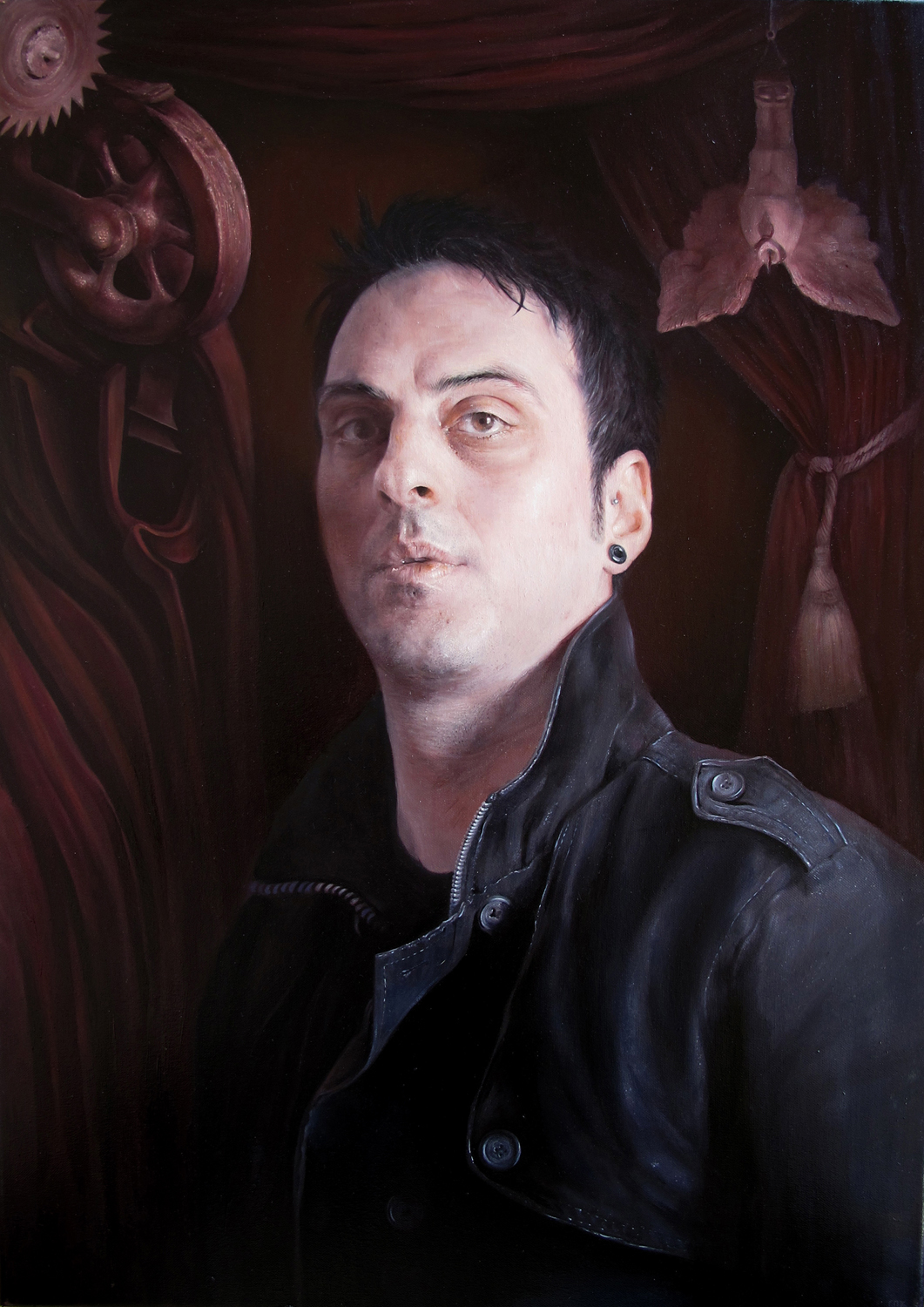
Untitled, 50 x 70cm (oil on canvas) 2013-14
Tell us a few words about your future plans…
I am taking part in Art-Athina (International Contemporary Art Fair), In the Tae Kwon Do Arena in Faliro, from May 25 to May 28 and in SWAB Barcelona (International Exhibition of Modern Art of Barcelona, Spain) in September, with Kaplanon Galleries.
Contact Information:
www.kavounis.gr
www.facebook.com/kavounis
www.instagram.com/yiorgos_p_kavounis


